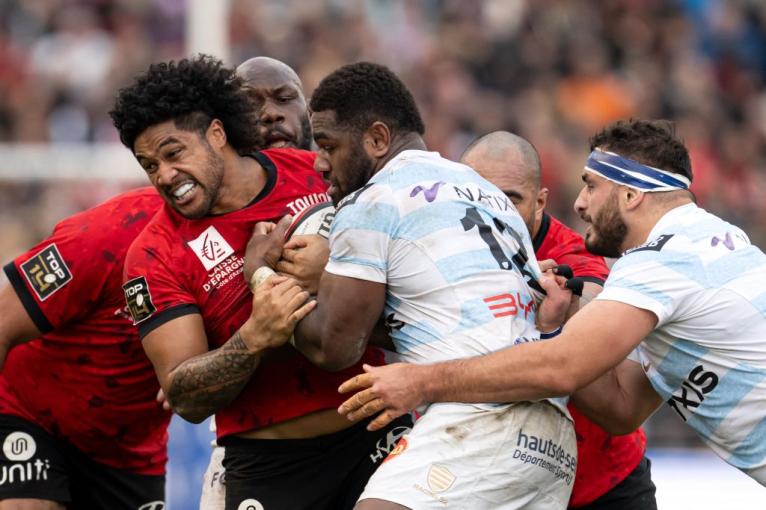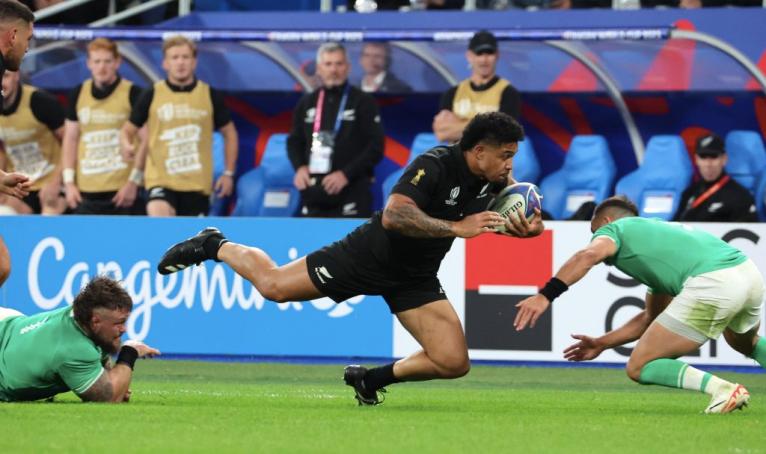To go or not to go? That is the question. The power struggle over eligibility criteria for All Blacks selection has provoked a tug of war in the minds of Kiwi players plying their trade abroad. Razor Robertson wants more flexibility in the rules, but the instinct at home is to batten down the hatches and keep the system which has served New Zealand so well for so long, utterly airtight.
Ex-Crusaders wingman Leicester Fainga’anuku is the latest to feel a pull that goes both ways. Fainga’anuku signed an 18-month contract with Top 14 giants Toulon but wants to return home in time to make a case for 2027 World Cup selection.
He made no bones about the paradoxical nature of the choice in a recent interview.
“I am going to miss this place, that’s for sure. I’ve loved Toulon, the Top 14, and all the guys I’ve played with.

“I like playing in New Zealand – but, for rugby, I prefer the Top 14.
“I had to make a difficult choice. I had to go home for my wife, my family. It was important for us to go home, even more so with the birth of my child. My son will grow up surrounded by his family.
“You know the rules as well as I do. The rules are tough, I can’t be selected for the All Blacks while being abroad. That is also one of the positive aspects of going back to New Zealand. I can offer my services to the All Blacks.”
The lure of the Top 14 is about far, far more than just money – as Wallaby outside-half Noah Lolesio found when he spent a transformative period with the same club on the Côte D’Azur as a Rugby World Cup 2023 medical ‘joker’. He described the three-month stint as ‘probably the most critical experience I’ve had so far in my career’.
Exposure to a more relaxed and open lifestyle in France dragged the Brumbies pivot out of the rugby hothouse and back into the real world in which there is a life outside the game.
“I’ve tried to take my approach from France back to here at the Brums and really loosen myself up, just enjoy it and not put so much pressure on myself as I’ve probably done in the last few years,” he said.
It is hard indeed to argue it has not had a positive impact on his performances for Joe Schmidt’s Wallabies. The Canberra playmaker is metamorphosing quickly into the 10 every Australia supporter hoped he would become, and cemented his place as a starter as after years spent wandering in a hypertense wilderness of ‘what ifs?’

The makeover for Fainga’anuku came via a change of position. He had been regarded primarily as a power wing back in New Zealand but in France he has played 18 of his 23 games at centre, and in the current season 13 has been his shirt exclusively at the fabled Stade Mayol. The switch had always been on his mind, but it happened rather too rarely to count in Christchurch.
“I always thought one day, I would switch to centre. I already had the opportunity to do it in New Zealand, but [head coach] Pierre [Mignoni] and the staff offered me a slightly longer stint. It was a privilege and I appreciated the opportunity.
“I feel like I have more influence on the game. You can manage the momentum of the match, you are also more connected to the teammates around you. You feel like you can help them – I love that! Now, I want to keep both facets, by being able to play on the wing as well as in the centre.
“I now understand what is expected of a winger or a centre. But, no matter the position, I am always ready to be on the field.”
New Zealand has always produced an abundance of high-quality back three talents, and on occasion it has chosen some unfortunate moments to a convert full-back or wing into a second five-eighth or centre. Mils Muliaina, Leon MacDonald, Christian Cullen will tell you all you need to know about that story. The time spent tinkering with the pairing of an erstwhile full-back [David Havili] with a left wing [Rieko Ioane] arguably cost Ian Foster’s All Blacks the chance to develop a winning midfield formula in time for the 2023 World Cup.
The duo currently favoured by Robertson [Jordie Barrett and Ioane] represents another back three transformation, but at least one of them has expressed exactly the same sentiments as Fainga’anuku. Barrett stated he was ‘most comfortable’ playing at second five-eighth while still in New Zealand, and nothing has changed with his new club Leinster.
“I would like to think I am a number 12 that can probably play 15, and that’s the way I see myself. I think most of my value is at 12 but I still enjoy 15, ever since transitioning into the midfield with the All Blacks and the Hurricanes.”
Where speed and the back three skillset often move inside in New Zealand, in France it tends to stay out on the edges. Power remains where it really matters – standing strong in the middle of the field, in the place where it can manage the momentum of matches more consistently and stay connected best to its mates.
When Fainga’anuku does return to New Zealand, I believe it will be with the idea of starting him at centre in the national side in time for the 2027 World Cup. That plan will have some inbuilt advantages for Razor: it will allow Leicester to reconnect with Richie Mo’unga and hasten the magician’s return from Japan, and it will encourage Jordie Barrett to take on more playmaking responsibility with a more powerful presence next to him.
Having only appeared in seven of Toulon’s first 13 games in the Top 14, Fainga’anuku was already the club leader in tackle-busts with 32. That is where you want him, breaking tackles down the middle of the field. First for Crusaders, and preferably off Mo’unga.
The latest iteration, translated to the number 13 jersey for Toulon, occurred in the club’s recent home game against Racing 92.
The power to bulldoze down the opposition 10 channel is reinforced by nice touch on the left-hand offload, and RCT promptly scored on the next phase of possession.
Fainga’anuku carries like a backline version of Ardie Savea, and his ability to generate metres-after-contact has another natural use on the pick-and-go [where he was used so effectively by the Christchurch outfit], or on short passes near the ruck, or down a skinny short side.
On defence Fainga’anuku is a natural jackal despite starting from a spot on the outside of the field. He already had four pilfers at the breakdown in his first 11 games for RCT despite limited playing time for his new club. That ranked him only one behind Les Rouges et Noirs’ best operator in that area [Englishman Lewis Ludlam] and 10th in the league overall.
Like Savea, Fainga’anuku gains in strength the lower he plays to the ground, on attack and defence alike. Contact with the earth only fuels his power, and that power belongs closer to the epicentre of the action.
New Zealand has a chance to reverse the recent trend of trying to shoehorn unlikely, and possibly unwilling back three talents into midfield with Fainga’anuki’s impending return. The current incumbent at 13 is Rieko Ioane, but some influential recent ex-All Blacks have rightly questioned his right to the role.
As Israel Dagg commented after New Zealand’s sole November tour defeat to France: “Rieko’s strengths are his speed, his ability to break on the outside, but defenders know that.
“You saw him trying to beat Gaël Fickou on the outside constantly, get the ball on an outside burst. So, if I’m a defender, I stay on his outside because he’s only going to beat you on the outside.
“I’m not really sold on Rieko as a centre. He’s a hell of a player, hell of an athlete. Big couple of weeks for him off the field [with the Johnny Sexton social media face-off in mind], but has he been able to deliver on the field?”
As a wing who prefers to play centre, Fainga’anuku can beat a defender on the outside with speed and fend, but that defender also needs to be mindful of his ability to plough through all but the most accurate and determined of tackles, straight ahead.
His experience with Toulon has confirmed power has a home at 13. The overseas makeover has already happened, and if Razor cannot make use of it, there will always been a welcome on the Riviera. As Pierre Mignoni said, “I know Scott Robertson. He had already warned me, when [Leicester] signed here, that he was young, that he would like to get him back. Maybe, in the future, I will be able to get him back too.”


Comments
Join free and tell us what you really think!
Sign up for free